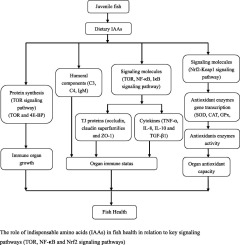当前位置:
X-MOL 学术
›
Comp. Biochem. Physiol. B Biochem. Mol. Biol.
›
论文详情
Our official English website, www.x-mol.net, welcomes your
feedback! (Note: you will need to create a separate account there.)
A review on fish immuno-nutritional response to indispensable amino acids in relation to TOR, NF-κB and Nrf2 signaling pathways: Trends and prospects.
Comparative Biochemistry and Physiology B: Biochemistry & Molecular Biology ( IF 1.9 ) Pub Date : 2019-12-05 , DOI: 10.1016/j.cbpb.2019.110389 Habte-Michael Habte-Tsion 1
Comparative Biochemistry and Physiology B: Biochemistry & Molecular Biology ( IF 1.9 ) Pub Date : 2019-12-05 , DOI: 10.1016/j.cbpb.2019.110389 Habte-Michael Habte-Tsion 1
Affiliation

|
Indispensable amino acids (IAAs) are important regulators of key metabolic pathways associated with protein synthesis, tight junction proteins, inflammatory cytokines and immune-antioxidant related signaling molecules. However, the information pertaining to the immune functions of IAAs in relation to molecular approaches for commercially important fish species are scarce and discordant. This review summarizes the dietary requirements for IAAs necessary for improved growth and immune response in variety of fish species, using molecular approaches (nutrigenomics), particularly the interrelationships between IAAs and genes. Briefly, antioxidant status of fish as well as gene transcriptions regulating antioxidant enzymes are profoundly governed by the nutritional factors including a set of IAAs, and these genes expression are often regulated by the nuclear factor erythoid 2-related factor 2 signaling pathway (Nrf2). IAAs level could also attenuate the inflammatory response in fish partly by down-regulating the expression levels of pro-inflammatory cytokines and up-regulating the anti-inflammatory cytokines. The regulation of these cytokines by IAAs could be mediated by the signaling molecules nuclear transcription factor-κB (NF-κB) and target of rapamycin (TOR). Overall, this review provides clear and recent molecular mechanisms of fish immuno-nutritional interrelation and highlights regulatory pathways underlying dietary IAAs mediated enhancement in the antioxidant, anti-inflammatory, and immune defense capacities, presenting trends and future perspectives.
中文翻译:

鱼类对必需氨基酸与TOR,NF-κB和Nrf2信号通路相关的免疫营养反应的综述:趋势和前景。
必需氨基酸(IAA)是与蛋白质合成,紧密连接蛋白,炎性细胞因子和免疫抗氧化剂相关的信号分子相关的关键代谢途径的重要调节剂。但是,与IAA的免疫功能相关的信息与商业上重要鱼类的分子方法有关的信息很少且不协调。这篇综述总结了使用分子方法(营养学),尤其是IAA与基因之间的相互关系,对改善各种鱼类的生长和免疫反应所必需的IAA的饮食要求。简而言之,鱼类的抗氧化状态以及调节抗氧化酶的基因转录受包括一系列IAA在内的营养因素的支配,这些基因的表达通常受核因子类红细胞2相关因子2信号通路(Nrf2)调控。IAAs水平也可以通过下调促炎性细胞因子的表达水平和上调抗炎性细胞因子来部分减轻鱼类的炎症反应。IAAs对这些细胞因子的调节可能由信号转导分子核转录因子-κB(NF-κB)和雷帕霉素的靶标(TOR)介导。总体而言,本综述提供了鱼类免疫营养相关性的清晰和近期分子机制,并突出了饮食中IAA介导的抗氧化,抗炎和免疫防御能力增强的调控途径,并提出了趋势和未来展望。IAAs水平也可以通过下调促炎性细胞因子的表达水平和上调抗炎性细胞因子来部分减轻鱼类的炎症反应。IAAs对这些细胞因子的调节可能由信号转导分子核转录因子-κB(NF-κB)和雷帕霉素的靶标(TOR)介导。总体而言,本综述提供了鱼类免疫营养相关性的清晰和近期分子机制,并强调了饮食IAA介导的抗氧化,抗炎和免疫防御能力增强的调控途径,并提出了趋势和未来展望。IAAs水平也可以通过下调促炎性细胞因子的表达水平和上调抗炎性细胞因子来部分减轻鱼类的炎症反应。IAAs对这些细胞因子的调节可能由信号转导分子核转录因子-κB(NF-κB)和雷帕霉素的靶标(TOR)介导。总体而言,本综述提供了鱼类免疫营养相关性的清晰和近期分子机制,并强调了饮食IAA介导的抗氧化,抗炎和免疫防御能力增强的调控途径,并提出了趋势和未来展望。IAAs对这些细胞因子的调节可能由信号转导分子核转录因子-κB(NF-κB)和雷帕霉素的靶标(TOR)介导。总体而言,本综述提供了鱼类免疫营养相关性的清晰和近期分子机制,并强调了饮食IAA介导的抗氧化,抗炎和免疫防御能力增强的调控途径,并提出了趋势和未来展望。IAAs对这些细胞因子的调节可能由信号转导分子核转录因子-κB(NF-κB)和雷帕霉素的靶标(TOR)介导。总体而言,本综述提供了鱼类免疫营养相关性的清晰和近期分子机制,并强调了饮食IAA介导的抗氧化,抗炎和免疫防御能力增强的调控途径,并提出了趋势和未来展望。
更新日期:2019-12-05
中文翻译:

鱼类对必需氨基酸与TOR,NF-κB和Nrf2信号通路相关的免疫营养反应的综述:趋势和前景。
必需氨基酸(IAA)是与蛋白质合成,紧密连接蛋白,炎性细胞因子和免疫抗氧化剂相关的信号分子相关的关键代谢途径的重要调节剂。但是,与IAA的免疫功能相关的信息与商业上重要鱼类的分子方法有关的信息很少且不协调。这篇综述总结了使用分子方法(营养学),尤其是IAA与基因之间的相互关系,对改善各种鱼类的生长和免疫反应所必需的IAA的饮食要求。简而言之,鱼类的抗氧化状态以及调节抗氧化酶的基因转录受包括一系列IAA在内的营养因素的支配,这些基因的表达通常受核因子类红细胞2相关因子2信号通路(Nrf2)调控。IAAs水平也可以通过下调促炎性细胞因子的表达水平和上调抗炎性细胞因子来部分减轻鱼类的炎症反应。IAAs对这些细胞因子的调节可能由信号转导分子核转录因子-κB(NF-κB)和雷帕霉素的靶标(TOR)介导。总体而言,本综述提供了鱼类免疫营养相关性的清晰和近期分子机制,并突出了饮食中IAA介导的抗氧化,抗炎和免疫防御能力增强的调控途径,并提出了趋势和未来展望。IAAs水平也可以通过下调促炎性细胞因子的表达水平和上调抗炎性细胞因子来部分减轻鱼类的炎症反应。IAAs对这些细胞因子的调节可能由信号转导分子核转录因子-κB(NF-κB)和雷帕霉素的靶标(TOR)介导。总体而言,本综述提供了鱼类免疫营养相关性的清晰和近期分子机制,并强调了饮食IAA介导的抗氧化,抗炎和免疫防御能力增强的调控途径,并提出了趋势和未来展望。IAAs水平也可以通过下调促炎性细胞因子的表达水平和上调抗炎性细胞因子来部分减轻鱼类的炎症反应。IAAs对这些细胞因子的调节可能由信号转导分子核转录因子-κB(NF-κB)和雷帕霉素的靶标(TOR)介导。总体而言,本综述提供了鱼类免疫营养相关性的清晰和近期分子机制,并强调了饮食IAA介导的抗氧化,抗炎和免疫防御能力增强的调控途径,并提出了趋势和未来展望。IAAs对这些细胞因子的调节可能由信号转导分子核转录因子-κB(NF-κB)和雷帕霉素的靶标(TOR)介导。总体而言,本综述提供了鱼类免疫营养相关性的清晰和近期分子机制,并强调了饮食IAA介导的抗氧化,抗炎和免疫防御能力增强的调控途径,并提出了趋势和未来展望。IAAs对这些细胞因子的调节可能由信号转导分子核转录因子-κB(NF-κB)和雷帕霉素的靶标(TOR)介导。总体而言,本综述提供了鱼类免疫营养相关性的清晰和近期分子机制,并强调了饮食IAA介导的抗氧化,抗炎和免疫防御能力增强的调控途径,并提出了趋势和未来展望。











































 京公网安备 11010802027423号
京公网安备 11010802027423号